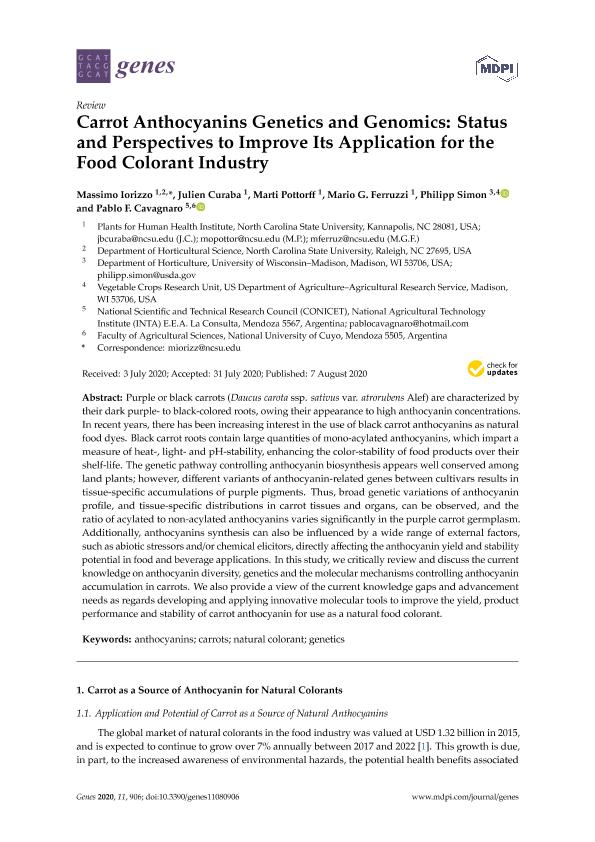Mostrar el registro sencillo del ítem
dc.contributor.author
Iorizzo, Massimo

dc.contributor.author
Curaba, Julien
dc.contributor.author
Pottorff, Marti
dc.contributor.author
Ferruzzi, Mario G.
dc.contributor.author
Simon, Pihilipp W.
dc.contributor.author
Cavagnaro, Pablo Federico

dc.date.available
2021-09-16T01:38:12Z
dc.date.issued
2020-08
dc.identifier.citation
Iorizzo, Massimo; Curaba, Julien; Pottorff, Marti; Ferruzzi, Mario G.; Simon, Pihilipp W.; et al.; Carrot anthocyanins genetics and genomics: Status and perspectives to improve its application for the food colorant industry; Multidisciplinary Digital Publishing Institute; Genes; 11; 8; 8-2020; 906-961
dc.identifier.issn
2073-4425
dc.identifier.uri
http://hdl.handle.net/11336/140463
dc.description.abstract
Purple or black carrots (Daucus carota ssp. sativus var. atrorubens Alef) are characterized bytheir dark purple- to black-colored roots, owing their appearance to high anthocyanin concentrations. In recent years, there has been increasing interest in the use of black carrot anthocyanins as natural food dyes. Black carrot roots contain large quantities of mono-acylated anthocyanins, which impart a measure of heat-, light- and pH-stability, enhancing the color-stability of food products over their shelf-life. The genetic pathway controlling anthocyanin biosynthesis appears well conserved among land plants; however, different variants of anthocyanin-related genes between cultivars results in tissue-specific accumulations of purple pigments. Thus, broad genetic variations of anthocyanin profile, and tissue-specific distributions in carrot tissues and organs, can be observed, and the ratio of acylated to non-acylated anthocyanins varies significantly in the purple carrot germplasm. Additionally, anthocyanins synthesis can also be influenced by a wide range of external factors, such as abiotic stressors and/or chemical elicitors, directly affecting the anthocyanin yield and stability potential in food and beverage applications. In this study, we critically review and discuss the current knowledge on anthocyanin diversity, genetics and the molecular mechanisms controlling anthocyanin accumulation in carrots. We also provide a view of the current knowledge gaps and advancement needs as regards developing and applying innovative molecular tools to improve the yield, product performance and stability of carrot anthocyanin for use as a natural food colorant.
dc.format
application/pdf
dc.language.iso
eng
dc.publisher
Multidisciplinary Digital Publishing Institute
dc.rights
info:eu-repo/semantics/openAccess
dc.rights.uri
https://creativecommons.org/licenses/by-nc-sa/2.5/ar/
dc.subject
ANTHOCYANINS
dc.subject
CARROT
dc.subject
NATURAL COLORANTS
dc.subject
GENETICS
dc.subject.classification
Horticultura, Viticultura

dc.subject.classification
Agricultura, Silvicultura y Pesca

dc.subject.classification
CIENCIAS AGRÍCOLAS

dc.title
Carrot anthocyanins genetics and genomics: Status and perspectives to improve its application for the food colorant industry
dc.type
info:eu-repo/semantics/article
dc.type
info:ar-repo/semantics/artículo
dc.type
info:eu-repo/semantics/publishedVersion
dc.date.updated
2021-09-01T13:54:36Z
dc.journal.volume
11
dc.journal.number
8
dc.journal.pagination
906-961
dc.journal.pais
Suiza

dc.journal.ciudad
Basilea
dc.description.fil
Fil: Iorizzo, Massimo. North Carolina State University. Department Of Food, Bioprocessing And Nutrition Sciences. Plants For Human Health Institute.; Estados Unidos
dc.description.fil
Fil: Curaba, Julien. North Carolina State University. Department Of Food, Bioprocessing And Nutrition Sciences. Plants For Human Health Institute.; Estados Unidos
dc.description.fil
Fil: Pottorff, Marti. North Carolina State University. Department Of Food, Bioprocessing And Nutrition Sciences. Plants For Human Health Institute.; Estados Unidos
dc.description.fil
Fil: Ferruzzi, Mario G.. North Carolina State University. Department Of Food, Bioprocessing And Nutrition Sciences. Plants For Human Health Institute.; Estados Unidos
dc.description.fil
Fil: Simon, Pihilipp W.. United States Department of Agriculture. Agricultural Research Service; Argentina. University of Wisconsin; Estados Unidos
dc.description.fil
Fil: Cavagnaro, Pablo Federico. Universidad Nacional de Cuyo. Facultad de Ciencias Agrarias. Departamento de Producción Agropecuaria. Cátedra de Horticultura y Floricultura; Argentina. Instituto Nacional de Tecnología Agropecuaria. Centro Regional Mendoza-San Juan. Estación Experimental Agropecuaria La Consulta; Argentina. Consejo Nacional de Investigaciones Científicas y Técnicas. Centro Científico Tecnológico Conicet - Mendoza; Argentina
dc.journal.title
Genes
dc.relation.alternativeid
info:eu-repo/semantics/altIdentifier/doi/http://dx.doi.org/ 10.3390/genes11080906
dc.relation.alternativeid
info:eu-repo/semantics/altIdentifier/url/https://www.mdpi.com/2073-4425/11/8/906
Archivos asociados
